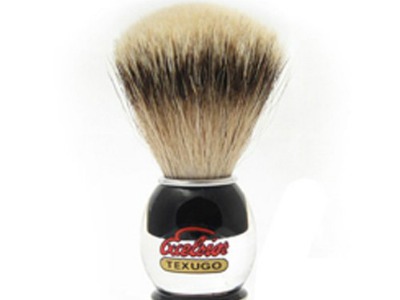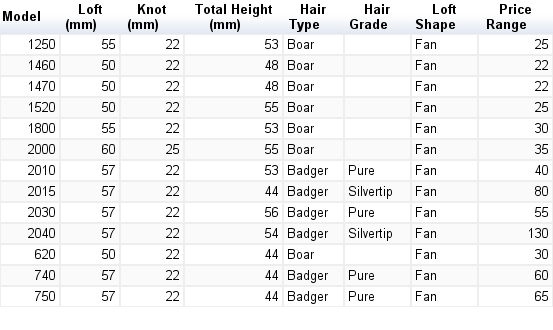
I have been looking at popular shaving brushes on the market (having previously looked at Vulfix, Simpsons, Truefitt and Hill, Rooney, Shavemac, and Savile Row). This post looks at Semogue. At the end of the series–just in time for the holiday gift-giving season–I’ll update the entire list and create a large, sortable table and also make the data available in a “CSV file” for importing into your favorite spreadsheet or database program.
Semogue
I admit that I am not particularly familiar with Semongue. They are evidently made in Portugal by a small family business. They do seem have a line of brushes with a very good value and I have started to see more and more references to them on the shaving forums.
What is your experience with Semongue?
On the table below I’ve listed the major specifications for the brushes currently being manufctured. “Model” refers to the model number of the brush. “Loft,” “Knot,” and “Handle” refer to the the dimensions, in millimeters, for the height of the hair, the diameter of the hair at the base, and the height of the brush’s handle, respectively. “Hair” indicates what kind of hair is used, along with a “Grade” (if any). The “Shape” of the hair refers to whether it is a fan-like shape or a bulb-like shape. Finally, price refers to the Manufacturer’s list price in US dollars. Although I have excersized care in researching these statistics I cannot guarantee they are exact.


One important way in which (some) Semogue brushes stand out, is in terms of the “tops” design of the knot. For example, the 620 has a ” 75% tops” knot, meaning that only 75% of all the hair in the knot, actually extend the full length of the loft. The remaining %25 are somewhat shorter. This design males for a remarkable combination of softness and backbone, which I find is unique for (in my case) the 620, which is the reason it is one of my favourite face lathering brushes.
For an explanation of the Semogue knot “tops” design, see e.g.:
http://shavenook.com/showthread.php?tid=4840
My daily driver is a Semogue 830. It is a great brush. What I like most about it, is that the knot density is just right. It’s not too tight, so as to be a lather hog. I also have a 620, which is a backbone beast. The small size of it allows for really precision lathering. I have 2 expensive badgers, but the Semogues are the ones I use most.
I’ve had a 2000 for two and a half years. I use it regularly in a short rotation.
It’s been a terrific brush and a great value in my opinion. I paid about twenty bucks then but I see it’s gone up so there must be good demand for them.
Unfortunately the finish is about completely gone from the handle. It hasn’t cracked yet – I figure when it does I can cut it loose and feel I had a good run with it. But I’ve learned my lesson, I’m sticking with artificial handles.
Hi,
Should the “Total Height” column really be “Handle”? It’s hard to visualize a brush with a loft of 55mm and a total height of just 53mm ;^)
Well, I just purchased my first Semogue brush last week, the 2011 Limited Edition Finest Bristle 1. I love this brush and it will more than likely replace my favorite badger as my daily brush. From my short experience with this brand, I highly recommend them.
Comments are closed.